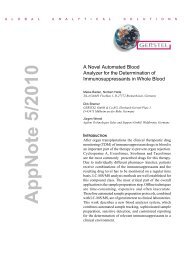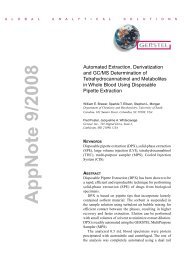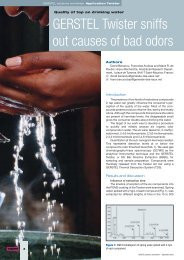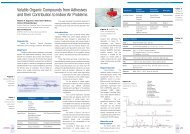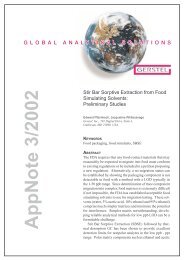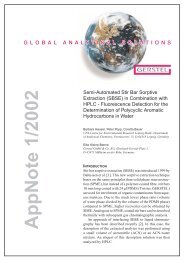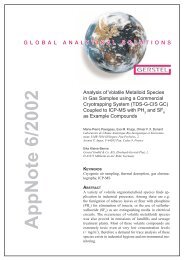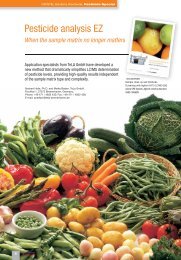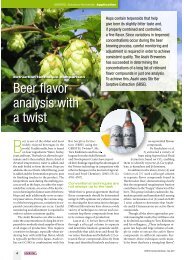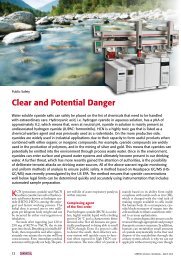GERSTEL Solutions No. 7 (pdf; 1,86 MB)
GERSTEL Solutions No. 7 (pdf; 1,86 MB)
GERSTEL Solutions No. 7 (pdf; 1,86 MB)
You also want an ePaper? Increase the reach of your titles
YUMPU automatically turns print PDFs into web optimized ePapers that Google loves.
<strong>GERSTEL</strong> <strong>Solutions</strong> Worldwide Application<br />
Health and Food Safety<br />
Fast and reliable<br />
answers regarding<br />
aflatoxins in foods<br />
If you are going to determine the concentration of mycotoxins in<br />
foods, in pharmaceutical products, or in raw materials used in their<br />
production, you will probably rely on Solid Phase Extraction (SPE)<br />
combined with LC/MS analysis. This approach ensures that detection<br />
limits will be lower than the maximum concentrations allowed by<br />
law. While long-established manual SPE procedures may leave little<br />
room for further optimization, automation of the process can provide<br />
laboratories with more reliable results in less than half the time.<br />
The well-stocked cheese counter may<br />
seem to tell a different story, but whoever<br />
consumes moldy foods – other<br />
than mold cheese – is putting his or her<br />
health at risk. This is due to mycotoxins:<br />
Toxins that are created as metabolites by certain<br />
molds. Mycotoxins can lead to acute<br />
illness as well as chronic ailments, caused<br />
by carcinogenic, mutagenic and hormone<br />
active properties that are especially harmful<br />
to infants and toddlers.<br />
To date, more than 300 mycotoxins,<br />
formed by approximately 250 mold types,<br />
have been found. For food safety purposes,<br />
however, only a few mycotoxins are of<br />
importance, such as those of the genus Aspergillus<br />
flavus and Aspergillus parasiticus.<br />
These molds thrive, especially under humid-warm<br />
conditions, on oily and starchy<br />
seeds such as peanuts, walnuts, hazelnuts,<br />
pistachios, almonds, figs, coco, grains, rice,<br />
corn and soy, as well as on dried fruits and<br />
spices.<br />
High concentrations of a group of mycotoxins<br />
called aflatoxins have been found,<br />
for example, in pistachios, figs and cereals.<br />
Aflatoxins are among the most potent human<br />
carcinogens found in plants. The aflatoxins<br />
B1, B2, G1, G2 and M1, produced by<br />
Aspergillus flavus and Aspergillus parasiticus,<br />
belong to the most potent mycotoxins<br />
that exist. Aflatoxin B1 poses the greatest<br />
hazard of all due to its carcinogenic properties.<br />
Because of the extreme toxicity of aflatoxins,<br />
EU legislation specifies very low acceptable<br />
daily intakes and low maximum<br />
residue limits.<br />
The risk of acute poisoning through<br />
high mycotoxin concentrations is relatively<br />
low in most of the developed world thanks<br />
to the overall good food quality. In Africa<br />
and parts of Asia, things can be quite<br />
different: Conditions for growing, storing<br />
and transporting agricultural products are<br />
frequently bad, resulting in moldy peanut<br />
or corn products. Consumption of moldy<br />
products regularly results in acute and even<br />
fatal aflatoxin poisoning. According to literature<br />
references, the lethal dose for an adult<br />
is 1 to 10 mg per kilogram body weight.<br />
Pervasive food contamination<br />
resulted in government regulation<br />
Mycotoxin contamination of food and<br />
feed is a global problem. The UN Food and<br />
Agricultural Organisation (FAO) estimates<br />
that up to 25% of the world’s food production<br />
is contaminated with mycotoxins.<br />
Approximately 20% of the EU‘s cereal harvest<br />
contains detectable amounts of mycotoxins.<br />
Due to the health risk posed by molds<br />
and due to their universal presence in cer-<br />
18<br />
<strong>GERSTEL</strong> <strong>Solutions</strong> Worldwide – May 2007



